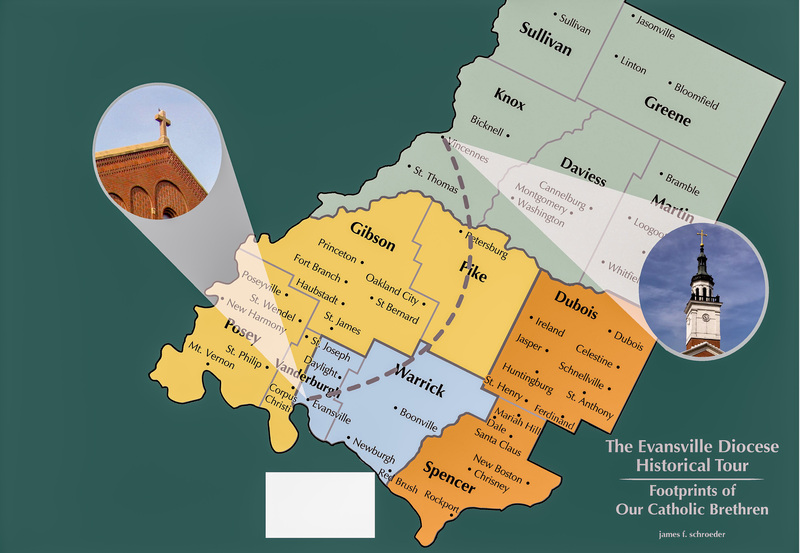BY JIM SCHROEDER
REFLECTION
Final thoughts

Editor’s note: This reflection was delivered after the final Mass of the Evansville Diocese Historical Tour, during the closing reception in the Raven’s Room below St. Benedict Cathedral School in Evansville.

Sixty-five visits and almost 2,000 sunrises ago, we found ourselves on the banks of the Wabash River. It was a subfreezing January morning, 15 days into the 12th year of the 21st century of our Lord. Shortly before Mass, we walked around the monument dedicated to George Rogers Clark and the critical moments of a fledgling nation. Years prior to his arrival, as early as 1734, Jesuit priests began visiting the site, eventually setting up the first church in 1748. A year later, parish records began; but the Jesuits were expelled from Vincennes in 1763 when it came under British control.
As we settled into the Minor Basilica of St. Francis Xavier, it was apparent that our comfortable existence that day was not built on the comfort of those early people. Long before artificial heating and lighting, they sowed the seeds of a city and a diocese on more than just survival. They had been summoned out of their fear and their hardships, just as the song did to us that day, to a new place, a new existence, to consider that their greatest accomplishment would be the legacy left of the long-since deceased.
As the tour settled into its early days, the landscapes varied from small stops on a country road to cities of vibrant growth. The contrast of how our Catholic ancestors chose to honor their faith was as apparent as the differences between the church buildings themselves. Large, expansive naves with endless decor gave way to simple, white edifices with maple pews. Yet, no matter the church in those early days, the spire soared high in the sky for settlers to see, and reminded us all of just where we should aspire.
Through the changing of the seasons and a growing family, the tour rolled on. Quiet, simple Masses with just a few intermingled with scintillating sounds of voices raised on high. Yet, it was the cemeteries that spoke the loudest and often demanded a stroll, where a familiar, stark white cross kept reoccurring. Moments in these hallowed grounds demanded an inner reflection, a contemplative consideration. Just what would these deceased say if they were alive today? Repeatedly confronted with these questions, the answers were elusive, but suggested one thing: We are all part of one another, those whom we know and those whom we will never see. Embedded in these graves were sacrifices of generations, so that we might live as we live today.
The years continued to pass, and the number of visits increased. Eras of civil unrest and world wars came and went. Periods of economic frenzy were followed by times of financial ruin, only to recover again. Parishes changed. People evolved. Yet, as we passed through each of these sacred doors, a collective weave became apparent. Names reappeared from past visits, and saintly depictions and stained-glass memorials became eerily familiar. These people were ours, and we are theirs! Centuries since that first cornerstone was laid, we are much the same. No matter the time or place or setting, we yearn for harmony; for happiness; for health. Still, just as those early people on the Wabash River, we yearn for a timelessness that demands a life of faith.
Today, we come to the end of a journey. There is nothing we can do to fittingly honor and commemorate those whom we have come before. But in what we do, we must continue to try. We started at the doors of the Minor Basilica, above the crypt where the earliest bishops are laid; we end today beneath the Cathedral, where Christ endures. In deep gratitude and humble admiration for those who laid the groundwork, we are called to consider just where we will go. Temptations abound to take the easy course; yet as it was not for them, so it is not for us. For, as Pope Benedict once said, “The world offers you comfort. But you were not made for comfort. You were made for greatness.” Just as our Catholic brethren strove for an unimaginable greatness, so we must, too. A journey ends today at Pentecost. A new one has just begun.
This reflection is from Jim Schroeder’s book “The Evansville Diocese Historical Tour: Footprints of Our Catholic Brethren.” Jim, his wife, Amy, and their kids live in Evansville. They are parishioners at Holy Redeemer Parish. Jim is a pediatric psychologist and Vice President of the psychology department at Easterseals Rehabilitation Center. “The full story, including illustrations, is available on Amazon or with his other books and articles at www.james-schroeder.com.”
